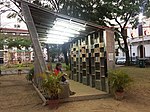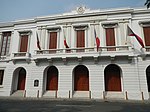Rizal Shrine (Intramuros)

The Rizal Shrine, also known as the Museo ni José Rizal Fort Santiago (transl. Museum of Jose Rizal in Fort Santiago) is a museum dedicated to the lifework of José Rizal. It is located inside Fort Santiago in Intramuros, Manila, Philippines, beside the Plaza de Armas. Fort Santiago served as barracks for Spanish artillery soldiers during Spain's colonization of the islands. The museum is located in the building where Rizal spent his final night and hid his famous poem Mi último adiós (My Last Farewell) in an oil lamp later given to his sister, Trinidad. The shrine is home to various memorabilia such as the shells he collected in Dapitan, books, manuscripts and artwork. In 2014, the National Historical Commission of the Philippines renovated the museum in order to attract younger audience.
Excerpt from the Wikipedia article Rizal Shrine (Intramuros) (License: CC BY-SA 3.0, Authors, Images).Rizal Shrine (Intramuros)
Soledad Promenade, Manila
Geographical coordinates (GPS) Address Nearby Places Show on map
Geographical coordinates (GPS)
| Latitude | Longitude |
|---|---|
| N 14.594444444444 ° | E 120.96972222222 ° |
Address
Spanish Barracks
Soledad Promenade
1002 Manila (Fifth District)
Philippines
Open on Google Maps










